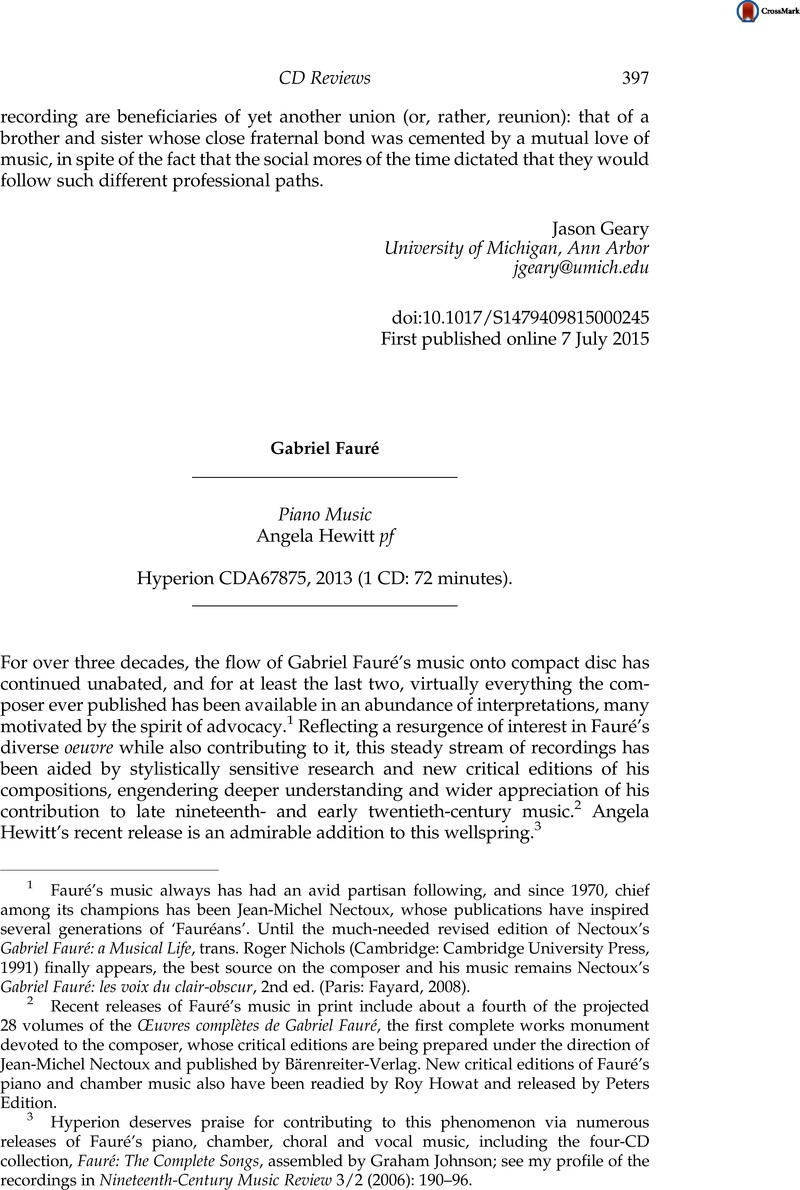No CrossRef data available.
Article contents
Gabriel Fauré - Piano Music Angela Hewitt pf Hyperion CDA67875, 2013 (1 CD: 72 minutes).
Published online by Cambridge University Press: 20 July 2015
Abstract

- Type
- CD Reviews
- Information
- Copyright
- © Cambridge University Press 2015
References
1 Fauré’s music always has had an avid partisan following, and since 1970, chief among its champions has been Jean-Michel Nectoux, whose publications have inspired several generations of ‘Fauréans’. Until the much-needed revised edition of Nectoux’s Gabriel Fauré: a Musical Life, trans. Roger Nichols (Cambridge: Cambridge University Press, 1991) finally appears, the best source on the composer and his music remains Nectoux’s Gabriel Fauré: les voix du clair-obscur, 2nd ed. (Paris: Fayard, 2008).
2 Recent releases of Fauré’s music in print include about a fourth of the projected 28 volumes of the Œuvres complètes de Gabriel Fauré, the first complete works monument devoted to the composer, whose critical editions are being prepared under the direction of Jean-Michel Nectoux and published by Bärenreiter-Verlag. New critical editions of Fauré’s piano and chamber music also have been readied by Roy Howat and released by Peters Edition.
3 Hyperion deserves praise for contributing to this phenomenon via numerous releases of Fauré’s piano, chamber, choral and vocal music, including the four-CD collection, Fauré: The Complete Songs, assembled by Johnson, Graham; see my profile of the recordings in Nineteenth-Century Music Review 3/2 (2006): 190–196Google Scholar.
4 See the Catalogue chronologique in Nectoux’s Gabriel-Fauré: les voix du clair-obscur, 709; although the first Valse-caprice’s completion date has not been precisely confirmed, Nectoux indicates it was published by Hamelle in 1883.
5 See also Hewitt’s double DVD, Bach Performance on the Piano (Hyperion DVDA68001), which features an illustrated lecture, as well as performances of Bach’s Partita in D major, the Italian Concerto and the Chromatic Fantasia and Fugue in D minor.
6 The Thème et variations was released by Metzler & Co. in March of 1896 and introduced in London on 10 December 1896 by Léon Delafosse; see Nectoux, , Gabriel Fauré: les voix du clair-obscur, 102Google Scholar. Fauré’s expanding international reputation soon paid off, for on 1 October 1896 he became Professor of Composition at the Paris Conservatoire; see Nectoux, Gabriel-Fauré: les voix du clair-obscur, 664. Two years later, Fauré would supply incidental music for the London premiere of Maurice Maeterlinck’s play, Pelléas et Mélisande.
7 See Nectoux, , Gabriel-Fauré: les voix du clair-obscur, 104Google Scholar, as well as Hewitt’s liner notes (p. 3).
8 Long, Marguerite, in her Au piano avec Gabriel Fauré (Paris: Julliard, 1963)Google Scholar, reports, ‘Gabriel Fauré avait deux formules qu’il affectionnait et répétait “six fois par heure”: “Des nuances”, disait-il, “et pas de changement de movement”’ (p. 103). [‘Gabriel Fauré had two sayings that he loved and repeated “six times an hour”: “Some nuances”, he said, “and without changing speed”’.] The latter comment articulates another feature of authentic Fauréan performance practice, the eschewal of Chopinesque rubato, which would undermine the rhythmic and metric subtleties within his music that depend upon a steady pulse.
9 Beyond Schubert’s and Chopin’s waltzes, more immediate precedents for Fauré’s own contributions include Liszt’s Valses-caprices d’après Schubert (S. 427; 1852), Tchaikovsky’s Valse-caprice, Op. 4 (1868) and Anton Rubinstein’s Valse-Caprice in E-flat (1870). Surely Maurice Ravel’s Valses nobles et sentimentales (1911) brings the tradition to its culmination, as well as full circle, for Ravel’s work, like Liszt’s, takes inspiration from Schubert’s Valses Nobles (Op. 77, D. 969; 1827) and Valses Sentimentales (Op. 50, D. 779; 1823).
10 Fauré’s 13 barcarolles, equally elusive, also have a primarily psychological, rather than depictive nature; see my ‘Rêveries within fantasies: The Barcarolles of Gabriel Fauré’, in L’analyse musicale aujourd’hui, ed. Ayari, Mondher, Jean-Michel Bardez and Xavier Hascher (Le Vallier: Editions Delatour France, 2015), 333–356Google Scholar.
11 See Nectoux, , Gabriel-Fauré: les voix du clair-obscur, 90Google Scholar and 485.
12 Fauré met Liszt on multiple occasions, and on one of these, Liszt attempted to sight-read Fauré’s Ballade but soon said, ‘I’ve run out of fingers’, asking the composer to continue; see Nectoux, Gabriel-Fauré: les voix du clair-obscur, 93–7, especially 96, n. 27. Liszt also gave Fauré advice on its orchestration, which was completed in 1881.
13 See Fauré’s, comments on the Ballade in a letter to Marie Clerc in Gabriel Fauré: His Life Through His Letters, ed. Jean-Michel Nectoux, trans. J.A. Underwood (London: Marion Boyars, 1980): 94Google Scholar. See also Howat, Roy, The Art of French Piano Music: Debussy, Ravel, Fauré, Chabrier (New Haven, CT: Yale University Press, 2009): 46–47Google Scholar, for their elucidation.





